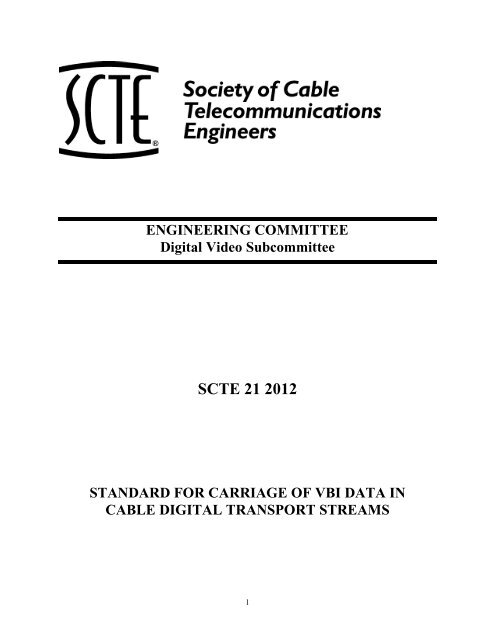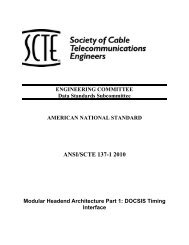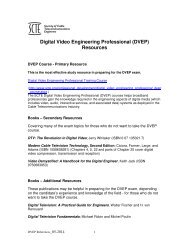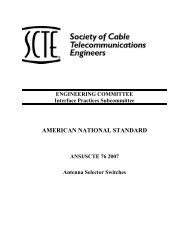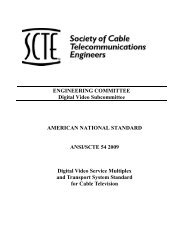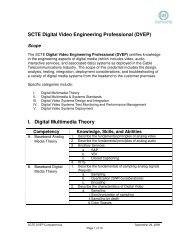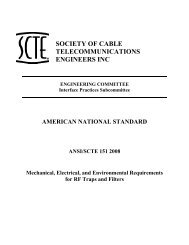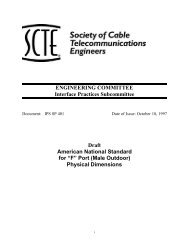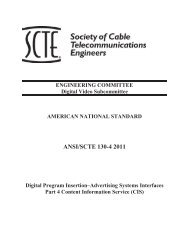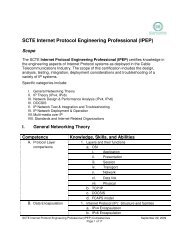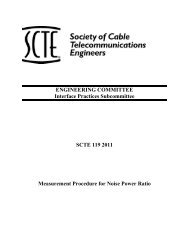vbi extensions for the atsc digital television standard - SCTE
vbi extensions for the atsc digital television standard - SCTE
vbi extensions for the atsc digital television standard - SCTE
You also want an ePaper? Increase the reach of your titles
YUMPU automatically turns print PDFs into web optimized ePapers that Google loves.
ENGINEERING COMMITTEE<br />
Digital Video Subcommittee<br />
<strong>SCTE</strong> 21 2012<br />
STANDARD FOR CARRIAGE OF VBI DATA IN<br />
CABLE DIGITAL TRANSPORT STREAMS<br />
1
NOTICE<br />
The Society of Cable Telecommunications Engineers (<strong>SCTE</strong>) Standards and Recommended<br />
Practices (hereafter called documents) are intended to serve <strong>the</strong> public interest by providing<br />
specifications, test methods and procedures that promote uni<strong>for</strong>mity of product,<br />
interchangeability, best practices and ultimately <strong>the</strong> long term reliability of broadband<br />
communications facilities. These documents shall not in any way preclude any member or nonmember<br />
of <strong>SCTE</strong> from manufacturing or selling products not con<strong>for</strong>ming to such documents, nor<br />
shall <strong>the</strong> existence of such <strong>standard</strong>s preclude <strong>the</strong>ir voluntary use by those o<strong>the</strong>r than <strong>SCTE</strong><br />
members, whe<strong>the</strong>r used domestically or internationally.<br />
<strong>SCTE</strong> assumes no obligations or liability whatsoever to any party who may adopt <strong>the</strong> documents.<br />
Such adopting party assumes all risks associated with adoption of <strong>the</strong>se documents, and accepts<br />
full responsibility <strong>for</strong> any damage and/or claims arising from <strong>the</strong> adoption of such Standards.<br />
Attention is called to <strong>the</strong> possibility that implementation of this document may require <strong>the</strong> use of<br />
subject matter covered by patent rights. By publication of this document, no position is taken<br />
with respect to <strong>the</strong> existence or validity of any patent rights in connection <strong>the</strong>rewith. <strong>SCTE</strong> shall<br />
not be responsible <strong>for</strong> identifying patents <strong>for</strong> which a license may be required or <strong>for</strong> conducting<br />
inquiries into <strong>the</strong> legal validity or scope of those patents that are brought to its attention.<br />
Patent holders who believe that <strong>the</strong>y hold patents which are essential to <strong>the</strong> implementation of<br />
this document have been requested to provide in<strong>for</strong>mation about those patents and any related<br />
licensing terms and conditions. Any such declarations made be<strong>for</strong>e or after publication of this<br />
document are available on <strong>the</strong> <strong>SCTE</strong> web site at http://www.scte.org.<br />
All Rights Reserved<br />
© Society of Cable Telecommunications Engineers, Inc. 2012<br />
140 Philips Road<br />
Exton, PA 19341<br />
2
Contents<br />
1. SCOPE .................................................................................................................... 6<br />
1.1 Document Structure .........................................................................................................6<br />
2. REFERENCES ........................................................................................................... 6<br />
2.1 Normative References ......................................................................................................6<br />
2.2 In<strong>for</strong>mative References ....................................................................................................7<br />
2.3 Published Materials ..........................................................................................................7<br />
3. COMPLIANCE NOTATION ..................................................................................... 7<br />
4. ACRONYMS AND ABBREVIATIONS ...................................................................... 8<br />
5. VIDEO USER DATA EXTENSIONS ........................................................................... 9<br />
5.1 Use of Picture User Data ..................................................................................................9<br />
5.2 Closed Captioning ............................................................................................................9<br />
5.3 Nielsen SID/AMOL Signals ...........................................................................................10<br />
5.4 O<strong>the</strong>r VBI Standards .....................................................................................................10<br />
6. PICTURE USER DATA SYNTACTIC EXTENSIONS ................................................... 11<br />
6.1 Syntax Conventions and Definitions .............................................................................11<br />
6.1.1 Method of Describing Bitstream Syntax ....................................................................11<br />
6.1.2 Reserved, Forbidden & Marker Bits ..........................................................................12<br />
6.1.3 Mnemonics .................................................................................................................13<br />
6.1.4 Start Codes .................................................................................................................13<br />
6.1.5 Definition of Functions ..............................................................................................13<br />
6.2 Bitstream Ordering of Picture User Data.....................................................................14<br />
6.3 Picture User Data Syntactic Extensions .......................................................................14<br />
6.4 Additional CEA-608 Data ..............................................................................................15<br />
6.5 Luminance PAM Data Structure ..................................................................................17<br />
6.6 Picture User Data Bandwidth ........................................................................................22<br />
3
List of Figures<br />
Figure 6-1. Next Start Code Function Syntax .............................................................. 13<br />
Figure 6-2. Extensions to ATSC Picture User Data Syntax .......................................... 15<br />
Figure 6-3. Additional EIA 608 Data Structure and Syntax ....................................... 16<br />
Figure 6-4. Luminance PAM Data Structure and Syntax. ......................................... 18<br />
Figure 6-5 Frequency Response of PRC Filter (Linear Scale) .................................... 20<br />
Figure 6-6 PRC Impulse Response ................................................................................. 21<br />
List of Tables<br />
Table 6–1. Bitstream Data Elements and Conditions ................................................. 11<br />
Table 6-2. Field Number <strong>for</strong> Additional CEA-608 Data .............................................. 16<br />
Table 6-3. Field Number <strong>for</strong> Picture User Data ............................................................ 18<br />
Table 6-4. Bits Per Symbol Encoding ............................................................................. 19<br />
Table 6-5. Pulse Shape. ................................................................................................. 20<br />
Table 6-6. PAM Alpha. ................................................................................................... 21
1. Scope<br />
This document defines a <strong>standard</strong> <strong>for</strong> <strong>the</strong> carriage of Vertical Blanking Interval (VBI) services in<br />
MPEG-2 compliant bitstreams constructed in accordance with ISO/IEC 13818-2. The approach<br />
builds upon a data structure defined in ATSC A/53 Part 4 (Digital Television Standard: Part 4 –<br />
MPEG-2 Video System Characteristics), and is designed to be backwards-compatible with that<br />
method.<br />
1.1 Document Structure<br />
The sections in this <strong>standard</strong> describing video user data <strong>extensions</strong> to MPEG-2 are organized as<br />
follows:<br />
• Section 1—Provides <strong>the</strong> document Scope and structure<br />
• Section 2—Lists Normative and In<strong>for</strong>mative References<br />
• Section 3—Defines <strong>the</strong> Compliance Notation <strong>for</strong> <strong>the</strong> document<br />
• Section 4—Defines <strong>the</strong> acronyms and abbreviations used in this specification<br />
• Section 5—Provides an overview of <strong>the</strong> VBI services supported<br />
• Section 6—Specifies <strong>the</strong> video bitstream syntax and semantics <strong>for</strong> picture user data<br />
<strong>extensions</strong><br />
2. References<br />
2.1 Normative References<br />
The following documents contain provisions, which, through reference in this text, constitute<br />
provisions of this <strong>standard</strong>. At <strong>the</strong> time of subcommittee approval, <strong>the</strong> editions indicated were<br />
valid. All <strong>standard</strong>s are subject to revision, and parties to agreement based on this <strong>standard</strong> are<br />
encouraged to investigate <strong>the</strong> possibility of applying <strong>the</strong> most recent editions of <strong>the</strong> documents<br />
listed below.<br />
1. ISO/IEC 13818-2: 2000, Generic Coding of Moving Pictures and Associated Audio,<br />
International Standard (MPEG-2 Video).<br />
2. ISO/IEC 13818-1:2007, Generic Coding of Moving Pictures and Associated Audio, ,<br />
International Standard, (MPEG-2 Systems).
3. ITU-R BT. 1700 , Characteristics of composite video signals <strong>for</strong> conventional analogue<br />
<strong>television</strong>s systems, 2005,<br />
4. ITU-R BT.601-5, Encoding Parameters of Digital Television <strong>for</strong> <strong>for</strong> Standard 4:3 and<br />
Wide-Screen 16:9 Aspect Ratios, 1995.<br />
5. ATSC A/53 Part 4, Digital Television Standard: Part 4 – MPEG-2 Video System<br />
Characteristics (2009).<br />
6. CEA-708-D, Digital Television (DTV) Closed Captioning, August 2008.<br />
7. ANSI/CEA-608-E, Line 21 Data Services, April 2008.<br />
2.2 In<strong>for</strong>mative References<br />
The following documents may provide valuable in<strong>for</strong>mation to <strong>the</strong> reader but are not required<br />
when complying with this <strong>standard</strong>.<br />
8. ANSI/<strong>SCTE</strong> 127, Carriage of Vertical Blanking Interval (VBI) Data in North American<br />
Digital Television Bitstreams, 2007.<br />
9. EIA-516, Joint EIA/CVCC Recommended Practice <strong>for</strong> Teletext: North American Basic<br />
Teletext Specification (NABTS), May 1988.<br />
10. ITU-R BT.653-3, Teletext Systems (World System Teletext), International<br />
Telecommunications Union, 1998.<br />
11. SMPTE ST 12M-1, 2008 Section 10, VITC.<br />
12. ANSI/<strong>SCTE</strong> 43, Digital Video Systems Characteristics <strong>standard</strong> <strong>for</strong> Cable Television,<br />
2004.<br />
13. <strong>SCTE</strong> 20 2012 Methods <strong>for</strong> carriage of closed captions and non-real time sampled video.<br />
2.3 Published Materials<br />
14. Code of Federal Regulations, Title 47 (Telecommunication), Part 73, Section 699.<br />
15. NTC Report No. 7, Video Facility Testing Technical Per<strong>for</strong>mance Objectives, 1976.<br />
16. AMOL Signal Specification, Nielsen Engineering and Technology, Document Number<br />
ACN 403-1122-000, Revision Level 1.4, January 16, 1995.<br />
17. AMOL II Signal Specification, Nielsen Engineering and Technology, Document Number<br />
ACN 403-1193-024, Revision Level 3.2, May 19, 1995.<br />
18. CEA-2020, O<strong>the</strong>r VBI wave<strong>for</strong>ms, 2006.<br />
3. Compliance Notation<br />
“SHALL”<br />
“SHALL NOT”<br />
This word or <strong>the</strong> adjective “REQUIRED” means that <strong>the</strong> item is an<br />
absolute requirement of this specification.<br />
This phrase means that <strong>the</strong> item is an absolute prohibition of this
specification.<br />
“SHOULD” This word or <strong>the</strong> adjective “RECOMMENDED” means that <strong>the</strong>re may<br />
exist valid reasons in particular circumstances to ignore this item, but<br />
<strong>the</strong> full implications should be understood and <strong>the</strong> case carefully<br />
weighted be<strong>for</strong>e choosing a different course.<br />
“SHOULD NOT” This phrase means that <strong>the</strong>re may exist valid reasons in particular<br />
circumstances when <strong>the</strong> listed behavior is acceptable or even useful,<br />
but <strong>the</strong> full implications should be understood and <strong>the</strong> case carefully<br />
weighed be<strong>for</strong>e implementing any behavior described with this label.<br />
“MAY” This word or <strong>the</strong> adjective “OPTIONAL” means that this item is truly<br />
optional. One vendor may choose to include <strong>the</strong> item because a<br />
particular marketplace requires it or because it enhances <strong>the</strong> product,<br />
<strong>for</strong> example; ano<strong>the</strong>r vendor may omit <strong>the</strong> same item.<br />
4. Acronyms and Abbreviations<br />
ATSC<br />
AMOL<br />
bslbf<br />
CCIR<br />
CEA<br />
EIA<br />
FCC<br />
IEC<br />
ISO<br />
LL<br />
lsb<br />
ML<br />
MP<br />
MPEG<br />
msb<br />
NTC<br />
NTSC<br />
PAL<br />
PAM<br />
SID<br />
uimsbf<br />
VBI<br />
VITC<br />
VITS<br />
Advanced Television Systems Committee<br />
Automated Measurement of Lineups<br />
bit string left bit first<br />
International Radio Consultative Committee<br />
Consumer Electronics Association<br />
Electronic Industries Association<br />
Federal Communications Commission<br />
International Electrotechnical Commission<br />
International Standards Organization<br />
Low Level<br />
least significant bit<br />
Main Level<br />
Main Profile<br />
Moving Picture Experts Group<br />
most significant bit<br />
Network Transmission Committee<br />
National Television System Committee<br />
Phase Alternate Line<br />
Pulse Amplitude Modulation<br />
Source Identification<br />
unsigned integer most significant bit first<br />
Vertical Blanking Interval<br />
Vertical Interval Time Code<br />
Vertical Interval Test Signal
5. Video User Data Extensions<br />
The video user data <strong>extensions</strong> to <strong>the</strong> MPEG-2 syntax and semantics described in this <strong>standard</strong><br />
provide a means to support a number of NTSC VBI services beyond those supported by CEA-<br />
708 and ATSC A/53 Part 4. While ATSC A/53 Part 4 only <strong>standard</strong>izes carriage of CEA-708<br />
closed captions (which includes carrying CEA-608 closed caption data from line 21), <strong>the</strong> VBI<br />
enhancements defined in this <strong>standard</strong> extend support to include:<br />
a) CEA-608-compliant closed captioning <strong>for</strong> one or more VBI lines o<strong>the</strong>r than line 21<br />
(Ref. [7] and Ref. [18])<br />
b) Nielsen Source Identification (SID)/Automated Measurement Of Lineups (AMOL)<br />
signals (Ref. [16], Ref. [18] and Ref. [17])<br />
c) North American Basic Teletext per <strong>the</strong> EIA-516 NABTS Specification (Ref. [9])<br />
d) World System Teletext (WST) (Ref. [10])<br />
e) Vertical Interval Time Code (VITC) (Ref. [11])<br />
Note: a) and b) have been updated by CEA-2020 (Ref.[18]).<br />
5.1 Use of Picture User Data<br />
The use of additional new data types within video user data is discouraged unless <strong>the</strong> data is<br />
inseparable from <strong>the</strong> video content and unlikely to be replaced or modified prior to decoder's<br />
passive receipt of this data. In o<strong>the</strong>r words, it shall not be necessary to process <strong>the</strong> data be<strong>for</strong>e<br />
reception in <strong>the</strong> decoder and no processing should be required after reception o<strong>the</strong>r than using it<br />
<strong>for</strong> NTSC wave<strong>for</strong>m reconstruction in <strong>the</strong> decoder.<br />
The NTSC VBI data defined in this <strong>standard</strong> is an example of data that is by not any practical<br />
means separable from video and is unlikely to be replaced or modified. This type of VBI data is<br />
considered a part of <strong>the</strong> input video wave<strong>for</strong>m that is digitized, compressed, transported, and<br />
reconstructed with an NTSC output (when <strong>the</strong> video mode is NTSC <strong>for</strong>mat).<br />
The VBI data encoded in video user data syntax is carried only to allow reconstruction at a<br />
receiver of <strong>the</strong> full original NTSC wave<strong>for</strong>m as it was input to <strong>the</strong> MPEG-2 encoder. In all o<strong>the</strong>r<br />
cases, applications residing in <strong>digital</strong> receivers should receive <strong>the</strong>ir pertinent data via elementary<br />
stream components of a <strong>digital</strong> service (i.e. via separate PID streams) and must not rely on <strong>the</strong><br />
user data structure.<br />
5.2 Closed Captioning<br />
Digital <strong>television</strong> services in North America carry closed caption in<strong>for</strong>mation as DTV Closed<br />
Captioning (DTVCC) <strong>standard</strong>ized in <strong>the</strong> CEA-708 <strong>standard</strong> (Ref. [6]). CEA-708 provides<br />
carriage of CEA-608 caption data as a part of <strong>the</strong> DTVCC data structure. Placement of this<br />
structure within <strong>the</strong> video user data is <strong>standard</strong>ized by ATSC A/53 Part 4 (Ref. [5]).
Many <strong>television</strong> services carry closed caption in<strong>for</strong>mation in line 21, field 1 of <strong>the</strong> VBI.<br />
According to <strong>the</strong> CEA-608 <strong>standard</strong>, closed caption data is also carried in line 21 of field 2. As<br />
noted, <strong>the</strong>se captions are also carried by CEA-708.<br />
Note 1: ANSI/<strong>SCTE</strong> 43 (reference [12]) specifies <strong>the</strong> ordering of closed caption structures that<br />
con<strong>for</strong>m to this specification and <strong>SCTE</strong> 20, 2012 (reference [13]).<br />
Note 2: <strong>SCTE</strong> 20, 2012 (reference [13]) specifies ano<strong>the</strong>r <strong>for</strong>mat <strong>for</strong> coding and transmission of<br />
closed captions that may be used in addition to what is specified here. Certain system service<br />
providers use <strong>the</strong> CEA-608 closed caption <strong>for</strong>mat to carry additional data in VBI lines o<strong>the</strong>r than<br />
line 21. The user data syntactic constructs described in this document allow multiple VBI lines<br />
per display field, including <strong>the</strong> <strong>standard</strong> line 21 closed caption usage.<br />
5.3 Nielsen SID/AMOL Signals<br />
AMOL encoding places in<strong>for</strong>mation in <strong>the</strong> VBI and includes a SID code and a date/time stamp. It<br />
is used by broadcasters to verify that programs or commercials air at <strong>the</strong> intended times. VBI user<br />
data syntactic constructs support one or more VBI lines <strong>for</strong> this purpose.<br />
5.4 O<strong>the</strong>r VBI Standards<br />
The encoding method described in this <strong>standard</strong> is applicable to VBI <strong>standard</strong>s in addition to<br />
those mentioned here because it is a general purpose method <strong>for</strong> representing a basic VBI<br />
wave<strong>for</strong>m. Most <strong>standard</strong>s in current use use two-level luminance encoding, however this<br />
<strong>standard</strong> accommodates multi-level pulse-amplitude modulation (PAM) coding as well. The<br />
technique is applicable to both PAL and NTSC. If <strong>the</strong> MPEG-2 video syntax carried a video<br />
program in PAL <strong>for</strong>mat, <strong>the</strong> syntax described here can be used as-is to carry VBI data and<br />
reconstruct a PAL <strong>standard</strong> video wave<strong>for</strong>m.<br />
Note: ANSI/<strong>SCTE</strong> 127 (reference [8]) specifies a different <strong>for</strong>mat <strong>for</strong> coding and transmission<br />
of VBI in<strong>for</strong>mation than what is specified here (luma-pam data).
6. Picture User Data Syntactic Extensions<br />
The method used in this document <strong>for</strong> describing video bitstream syntax is <strong>the</strong> same as that used<br />
in <strong>the</strong> MPEG-2 Video Standard, ISO/IEC 13818-2. The syntactic <strong>extensions</strong> to MPEG-2 Main<br />
Profile at Main Level operation <strong>for</strong> VBI services are implemented using <strong>the</strong> picture user data<br />
syntax defined in subsection 6.2.<br />
6.1 Syntax Conventions and Definitions<br />
6.1.1 Method of Describing Bitstream Syntax<br />
Those ISO/IEC 13818-2 conventions and definitions that appear in VBI user data syntax are<br />
reviewed in <strong>the</strong> remainder of this subsection.<br />
As exemplified in Table 6–1, this syntax resembles C-code and uses <strong>the</strong> convention that a variable or<br />
expression evaluating to a non-zero value is equivalent to a condition that is true.<br />
Table 6–1. Bitstream Data Elements and Conditions<br />
while ( condition ) { If <strong>the</strong> condition is true, <strong>the</strong>n <strong>the</strong> group of data elements<br />
data_element<br />
occurs next in <strong>the</strong> data stream. This repeats until <strong>the</strong><br />
. . . condition is not true.<br />
}<br />
do {<br />
data_element<br />
The data element always occurs at least once.<br />
. . .<br />
} while ( condition ) The data element is repeated until <strong>the</strong> condition is not<br />
true.<br />
if ( condition) {<br />
If <strong>the</strong> condition is true, <strong>the</strong>n <strong>the</strong> first group of data<br />
data_element<br />
elements occurs next in <strong>the</strong> data stream.<br />
. . .<br />
} else { If <strong>the</strong> condition is not true, <strong>the</strong>n <strong>the</strong> second group of data<br />
data_element<br />
elements occurs next in <strong>the</strong> data stream.<br />
. . .<br />
}<br />
<strong>for</strong> ( i = 0; i < n; i++) { The group of data elements occurs n times. Conditional<br />
data_element<br />
constructs within <strong>the</strong> group of data elements may depend<br />
. . . on <strong>the</strong> value of <strong>the</strong> loop control variable i, which is set to<br />
} zero <strong>for</strong> <strong>the</strong> first occurrence, incremented to one <strong>for</strong> <strong>the</strong><br />
second occurrence, and so <strong>for</strong>th.<br />
/* comment ... */ Explanatory comment that may be deleted entirely<br />
without in any way altering <strong>the</strong> syntax.<br />
1
Each data item in <strong>the</strong> bitstream appears in bold type and is described by its name, its length in<br />
bits, and a mnemonic <strong>for</strong> its type and order of transmission. The action caused by a decoded data<br />
element in a bitstream depends on <strong>the</strong> value of that data element and on data elements previously<br />
decoded. The constructs in normal type in <strong>the</strong> above table are used to express <strong>the</strong> conditions<br />
when data elements are present.<br />
A group of data elements may contain nested conditional constructs. For compactness, <strong>the</strong> { } are<br />
omitted when only one data element follows. Array data is represented as follows:<br />
data_element[n]<br />
data_element[m][n]<br />
<strong>the</strong> n+1th element of an array of data<br />
<strong>the</strong> m+1, n+1th element of a two-dimensional array of data<br />
While <strong>the</strong> syntax descriptions given in this document are expressed in procedural terms, it should<br />
not be assumed that subsection 6.2 implements a satisfactory decoding procedure. In particular,<br />
it defines a correct and error-free input bitstream <strong>for</strong> compatible encoders. Actual decoders must<br />
include means to look <strong>for</strong> start codes in order to begin decoding correctly, and to identify errors,<br />
erasures and insertions while decoding. Nei<strong>the</strong>r <strong>the</strong> methods to identify <strong>the</strong>se situations nor <strong>the</strong><br />
actions to be taken are specified in this document.<br />
6.1.2 Reserved, Forbidden & Marker Bits<br />
The terms reserved and <strong>for</strong>bidden are used in <strong>the</strong> description of some values of several fields in<br />
<strong>the</strong> coded bitstream. These are reproduced from Ref [1] section 5.3 <strong>for</strong> convenience here.<br />
reserved—Indicates that <strong>the</strong> value may be used in <strong>the</strong> future <strong>for</strong> ISO/IEC-defined<br />
<strong>extensions</strong>.<br />
<strong>for</strong>bidden—Indicates a value that shall never be used (usually in order to avoid emulation of<br />
start codes).<br />
marker_bit—Indicates a one-bit field in which <strong>the</strong> value zero is <strong>for</strong>bidden (and it <strong>the</strong>re<strong>for</strong>e<br />
shall have <strong>the</strong> value '1'). These marker bits are introduced at several points in <strong>the</strong> syntax to<br />
avoid start code emulation.<br />
Operators<br />
+ Addition.<br />
- Subtraction (as a binary operator) or negation (as a unary operator).<br />
++ Increment.<br />
- - Decrement.<br />
> Greater than.<br />
>= Greater than or equal to.<br />
< Less than.<br />
== Equal to.<br />
!= Not equal to.<br />
= Assignment operator.<br />
6.1.3 Mnemonics<br />
The following mnemonics are defined to describe <strong>the</strong> different data types used in <strong>the</strong> user data<br />
syntax described in subsection 6.2:<br />
bslbf—Bit string, left bit first, where “left” is <strong>the</strong> order in which bit strings are written in <strong>the</strong><br />
specification. Bit strings are written as a string of 1s and 0s within single quote marks, e.g.<br />
‘1000 0001’. Blanks within a bit string are <strong>for</strong> ease of reading and have no significance.<br />
uimsbf—Unsigned integer, most significant bit first.<br />
6.1.4 Start Codes<br />
Start codes are specific bit patterns that do not o<strong>the</strong>rwise occur in <strong>the</strong> video stream. Each start<br />
code consists of <strong>the</strong> 24-bit start code prefix string ‘0000 0000 0000 0000 0000 0001’ followed by<br />
an 8-bit integer that identifies <strong>the</strong> type of start code as described in ISO/IEC 13818-2. Start<br />
codes are always byte aligned, and may be preceded by any number of zero stuffing bits.<br />
6.1.5 Definition of Functions<br />
The following utility functions <strong>for</strong> picture coding algorithms are defined:.<br />
bytealigned()<br />
nextbits()<br />
next_start_code()<br />
returns 1 if <strong>the</strong> next bit in <strong>the</strong> bitstream is <strong>the</strong> first bit in a<br />
byte. O<strong>the</strong>rwise it returns 0.<br />
permits comparison of a bit string with <strong>the</strong> next bits to be<br />
decoded in <strong>the</strong> bitstream.<br />
removes any zero bit and zero byte stuffing and locates <strong>the</strong><br />
next start code as defined in Figure 6-1.<br />
No. of bits Mnemonic<br />
next_start_code() {<br />
while ( !bytealigned() ) 1 0<br />
zero_bit<br />
while ( nextbits() != '0000 0000 0000 0000 0000<br />
8 0000 0000<br />
0001' )<br />
zero_byte<br />
}<br />
Figure 6-1. Next Start Code Function Syntax<br />
1
6.2 Bitstream Ordering of Picture User Data<br />
In order to comply with this <strong>standard</strong>, an encoder shall satisfy all <strong>the</strong> following general<br />
requirements with regard to VBI data:<br />
1. The picture user data shall be packed in decode order, storing <strong>the</strong> VBI data to be<br />
reconstructed from a given picture in <strong>the</strong> picture user data of <strong>the</strong> same picture.<br />
2. The VBI data <strong>for</strong> <strong>the</strong> repeated field shall be transported with <strong>the</strong> picture that transports <strong>the</strong><br />
video data <strong>for</strong> <strong>the</strong> field to be repeated.<br />
3. For a given picture and VBI data type, all <strong>the</strong> VBI data <strong>for</strong> <strong>the</strong> first display field shall be<br />
followed by all <strong>the</strong> VBI data <strong>for</strong> <strong>the</strong> second display field followed by all <strong>the</strong> VBI data <strong>for</strong> <strong>the</strong><br />
third (repeated) display field, if present. Also, <strong>for</strong> a given picture, VBI data type, and field,<br />
all <strong>the</strong> VBI data <strong>for</strong> <strong>the</strong> first line shall be followed by all <strong>the</strong> VBI data <strong>for</strong> <strong>the</strong> second line,<br />
etc. 1<br />
4. Note from <strong>the</strong> syntax definition in subsection 6.3 that a compliant bitstream will only contain<br />
one picture user data construct with <strong>the</strong> user_data_type_code value of 0x03 in any given<br />
picture header. O<strong>the</strong>r user data constructs with o<strong>the</strong>r user_data_type_code values might be<br />
found, however.<br />
6.3 Picture User Data Syntactic Extensions<br />
The picture user data syntax to support VBI services is shown in Figure 6-2, where non-shaded<br />
cells highlight syntactic <strong>extensions</strong> to <strong>the</strong> ATSC/CEA syntax described in A/53 Part 4 Ref. [5]<br />
and CEA-708 Ref. [6]. Support <strong>for</strong> reconstruction of CEA-608 captions <strong>for</strong> insertion into <strong>the</strong><br />
NTSC VBI by receivers that provide this function using <strong>SCTE</strong> 20 (Ref.[13]), requires dual<br />
carriage of CEA-608 captions using <strong>the</strong> ATSC/CEA syntax described in A/53 Part 4 Ref.[5] and<br />
CEA-708 Ref. [6] (user_data_type_code value of 0x03 and cc_type values of ‘00’ or ‘01’) and<br />
<strong>SCTE</strong> 20.<br />
In Figure 6-2 (below) <strong>the</strong> ATSC/CEA syntax is reproduced as a service to <strong>the</strong> reader (and shown<br />
with shading). The definitive definition exists in ATSC A/53 Part 4 (Ref. [5]) and CEA-708<br />
(Ref. [6]). As shown, <strong>the</strong> ATSC syntax is extensible via <strong>the</strong> definition of additional<br />
user_data_type_code values. This <strong>standard</strong> defines type code value 0x04 as additional_EIA_608_data()<br />
(see Figure 6-3) and type code value 0x05 as luma_PAM_data() (see Figure 6-4). The following<br />
sections define <strong>the</strong>se data structures.<br />
Note: Since <strong>the</strong> transfer of <strong>standard</strong>ization of closed captions from EIA to CEA resulted in<br />
different document names, this document refers to both CEA-608 and CEA-708 by those terms.<br />
In <strong>the</strong> bitstream syntax below, however, <strong>the</strong> variable names will continue to use “EIA” <strong>for</strong><br />
historical continuity.<br />
1 As an example, a three-field film-mode picture with a f2,f1,f2 display order and closed captions on lines 14, 16, and 21 of field 2 and lines<br />
15 and 21 of field 1 are sent in order: d1-14, d1-16, d1-21, d2-15, d2-21, d3-14, d3-16, d3-21, where f1 is <strong>the</strong> odd field, f2 is <strong>the</strong> even field,<br />
d1 is <strong>the</strong> first display field, d2 is <strong>the</strong> second display field, and d3 is <strong>the</strong> third display field.<br />
1
user_data( ) {<br />
}<br />
No. of<br />
bits<br />
user_data_start_code 32 Bslbf<br />
ATSC_identifier 32 Bslbf<br />
user_data_type_code 8 Uimsbf<br />
if (user_data_type_code == ‘0x03’) {<br />
}<br />
reserved 1 ’1’<br />
process_cc_data_flag 1 Bslbf<br />
zero_bit 1 ’0’<br />
cc_count 5 Uimsbf<br />
Mnemonic<br />
reserved 8 ‘1111 1111’<br />
<strong>for</strong> ( i=0 ; i < cc_count ; i++ ) {<br />
}<br />
one_bits 5 ‘1 1111’<br />
cc_valid 1 Bslbf<br />
cc_type 2 Bslbf<br />
cc_data_1 8 Bslbf<br />
cc_data_2 8 Bslbf<br />
marker_bits 8 ‘1111 1111’<br />
} else if (user_data_type_code == ‘0x04’)<br />
additional_EIA_608_data()<br />
else if (user_data_type_code == ‘0x05’)<br />
luma_PAM_data()<br />
else<br />
ATSC_reserved_user_data<br />
next_start_code()<br />
Figure 6-2. Extensions to ATSC Picture User Data Syntax<br />
6.4 Additional CEA-608 Data<br />
Figure 6-3 defines <strong>the</strong> additional_EIA_608_data() data structure.<br />
14
additional_CEA_608_data() {<br />
marker_bits 3 ‘111’<br />
}<br />
additional_cc_count 5 Uimsbf<br />
<strong>for</strong> ( i=0 ; i < additional_cc_count ; i++ ) {<br />
additional_cc_valid 1 Bslbf<br />
additional_cc_line_offset 5 uimsbf<br />
additional_cc_field_number 2 Uimsbf<br />
additional_cc_data_1 8 Bslbf<br />
additional_cc_data_2 8 Bslbf<br />
}<br />
while( nextbits() != ‘0000 0000 0000 0000 0000 0001’ )<br />
additional_type_4_data 8<br />
Figure 6-3. Additional CEA 608 Data Structure and Syntax<br />
additional_cc_count—A five-bit integer (values in <strong>the</strong> range [1:31]) indicating <strong>the</strong> number of<br />
lines of CEA-608 to be defined following <strong>the</strong> field. All such constructs must occur in <strong>the</strong><br />
intended display order, assuming an interlaced display line and field display order.<br />
additional_cc_valid—A Boolean flag that indicates, when set, that <strong>the</strong> two bytes of additional<br />
closed caption data to follow are valid. When <strong>the</strong> flag is false, <strong>the</strong> data shall be ignored by <strong>the</strong><br />
decoder. The additional_cc_valid flag may be set to zero to create a place-holder <strong>for</strong> closed<br />
caption data to be inserted into <strong>the</strong> <strong>digital</strong> multiplex downstream from <strong>the</strong> encoder.<br />
additional_cc_line_offset—A five-bit integer (values in <strong>the</strong> range [1:31]) giving <strong>the</strong> offset in<br />
lines from which <strong>the</strong> CEA-608 closed caption data originated relative to <strong>the</strong> base VBI frame<br />
line (line 9 of 525-line [NTSC and PAL/M] field 1, line 272 of 525-line field 2, line 5 of 625-<br />
line [all PAL except PAL/M] field 1, and line 318 of 625-line field 2), as specified in ITU-R<br />
BT. 1700 (Ref. [3]).<br />
additional_cc_field_number—The number of <strong>the</strong> field, in display order, from which <strong>the</strong><br />
CEA-608 data originated, interpreted in <strong>the</strong> following Table.<br />
Table 6-2. Field Number <strong>for</strong> Additional CEA-608 Data<br />
additional_cc_<br />
field_number<br />
Meaning<br />
00 Forbidden<br />
01 1st display field<br />
10 2nd display field<br />
11 3rd display field (<strong>the</strong> repeated field in film<br />
mode).<br />
15
additional_cc_data_1—The first 8-bit byte of CEA-608 closed caption data to be<br />
reconstructed on <strong>the</strong> line identified by additional_cc_line_offset within <strong>the</strong> field identified by<br />
additional_cc_field_number.<br />
additional_cc_data_2—The second 8-bit byte of CEA-608 closed caption data to be<br />
reconstructed.<br />
additional_type_4_data—Reserved <strong>for</strong> future use by <strong>SCTE</strong>.<br />
6.5 Luminance PAM Data Structure<br />
Figure 6-4 defines <strong>the</strong> luma_PAM_data() structure.<br />
luma_PAM_data() {<br />
marker_bits 3 ‘111’<br />
luma_PAM_count 5 Uimsbf<br />
<strong>for</strong> (i=0 ; i
}<br />
symbol_bit 1 Bslbf<br />
}<br />
while ( !bytealigned() )<br />
marker_bit var Bslbf<br />
}<br />
while( nextbits() != ‘0000 0000 0000 0000 0000 0001’ ) {<br />
additional_type_5_data 8<br />
Figure 6-4. Luminance PAM Data Structure and Syntax.<br />
luma_PAM_count—A five-bit integer (values in <strong>the</strong> range [0:31]) indicating <strong>the</strong> number of<br />
Luminance PAM constructs following <strong>the</strong> field. All such constructs must occur in <strong>the</strong><br />
intended display order, assuming an interlaced display line and field display order.<br />
luma_PAM_priority—A number between 0 and 3 indicating <strong>the</strong> priority of constructs in<br />
picture reconstruction where different levels of hardware capability exist.<br />
field_number—The number of <strong>the</strong> field, in display order, from which <strong>the</strong> VBI data originated,<br />
interpreted in Table 6-3.<br />
Table 6-3. Field Number <strong>for</strong> Picture User Data<br />
field_number<br />
Meaning<br />
00 Forbidden<br />
01 1st display field<br />
10 2nd display field<br />
11 3rd display field (<strong>the</strong> repeated field in film<br />
mode).<br />
start_sample—A 9-bit unsigned integer (values in <strong>the</strong> range [0:511]) which indicates <strong>the</strong><br />
sample of <strong>the</strong> reconstructed luminance line at which <strong>the</strong> transition into <strong>the</strong> first Luminance<br />
PAM symbol shall start. start_sample shall be in <strong>the</strong> same units as ITU-R BT.601-5 (Ref. [4])<br />
samples and shall be relative to <strong>the</strong> first sample of ITU-R BT.601-5 reconstructed frames.<br />
bits_per_symbol—A 3-bit enumerated type that specifies <strong>the</strong> number of bits per symbol<br />
according to <strong>the</strong> following table.<br />
17
Table 6-4. Bits Per Symbol Encoding<br />
bits_per_symbol<br />
000 Forbidden<br />
Meaning<br />
001 One bit per symbol: two-level PAM encoding<br />
010 Two bits per symbol: four-level PAM coding<br />
011 Three bits per symbol: eight-level PAM coding<br />
100 Four bits per symbol: sixteen-level PAM coding<br />
101-111 reserved <strong>for</strong> future use<br />
PAM_increment—A 6-bit unsigned integer (values in <strong>the</strong> range [1:63]) which indicates <strong>the</strong><br />
Luminance PAM symbol clock increment value and takes on values that describe, toge<strong>the</strong>r<br />
with PAM_modulus, <strong>the</strong> relationship of <strong>the</strong> Luminance PAM symbol clock to a 27 MHz<br />
reference. See <strong>the</strong> semantics of PAM_modulus <strong>for</strong> more details.<br />
PAM_modulus—A 10-bit unsigned integer (values in <strong>the</strong> range [2:1023]) which indicates <strong>the</strong><br />
Luminance PAM symbol clock modulus value and takes on values that describe, toge<strong>the</strong>r with<br />
PAM_increment, <strong>the</strong> relationship of <strong>the</strong> Luminance PAM symbol clock to a 27 MHz reference.<br />
Specifically, PAM_increment and PAM_modulus are related to <strong>the</strong> Luminance PAM symbol rate as:<br />
PAM_increment / PAM_modulus = Luminance PAM symbol rate / system_clock_frequency 2<br />
where<br />
system_clock_frequency is specified in ISO/IEC 13818-1 as 27 MHz ± 30 ppm.<br />
low_amplitude_level—An 8-bit unsigned integer (values in <strong>the</strong> range [1:254] which indicates<br />
<strong>the</strong> amplitude at which symbols of <strong>the</strong> lowest amplitude value shall be reconstructed in units<br />
of amplitude of ITU-R BT.601-5 (Ref. [4]) reconstructed frames.<br />
high_amplitude_level— An 8-bit unsigned integer (values in <strong>the</strong> range [1:254] which<br />
indicates <strong>the</strong> amplitude at which symbols of <strong>the</strong> highest amplitude value shall be reconstructed<br />
in units of amplitude of ITU-R BT.601-5 (Ref. [4]) reconstructed frames.<br />
line_offset—A five-bit integer (values in <strong>the</strong> range [1:31]) giving <strong>the</strong> offset in lines from which<br />
<strong>the</strong> Luminance PAM data originated relative to <strong>the</strong> base VBI frame line (line 9 of 525-line<br />
[NTSC and PAL/M] field 1, line 272 of 525-line field 2, line 5 of 625-line [all PAL except<br />
PAL/M] field 1, and line 318 of 625-line field 2), as specified in ITU-R BT. 1700 (Ref. [3]).<br />
pulse_shape—A 3-bit unsigned integer which indicates <strong>the</strong> shape of <strong>the</strong> pulses which shall be<br />
used to reconstruct this line of Luminance PAM. The meaning of pulse_shape is given in Table<br />
6-5.<br />
2 The value of nrz_increment must not exceed nrz_modulus-1.<br />
18
Table 6-5. Pulse Shape.<br />
pulse_shape<br />
000 Rectangular<br />
001 raised_cosine<br />
Meaning<br />
010 PRC—partial response coding<br />
011-111 Reserved<br />
The pulse shape of a PRC signaling system as described by:<br />
H( ω) = 2 * T *cos( ω T 2 )<br />
in <strong>the</strong> frequency domain , as represented in Figure 6-5 or<br />
4 t T<br />
h( t) * cos( π<br />
=<br />
* )<br />
2 2<br />
π ( 1−<br />
4 * t T )<br />
in <strong>the</strong> time domain, as represented in Figure 6-6.<br />
2.5<br />
2<br />
1.5<br />
1<br />
0.5<br />
0<br />
-0.5<br />
-PI/T 0 PI/T<br />
Figure 6-5 Frequency Response of PRC Filter (Linear Scale)<br />
19
1.4<br />
1.2<br />
1<br />
0.8<br />
0.6<br />
0.4<br />
0.2<br />
0<br />
-2*T<br />
-0.2<br />
-T 0 +T +2*T +3*T<br />
Figure 6-6 PRC Impulse Response<br />
symbol_to_transition_ratio—An 8-bit unsigned integer (values in <strong>the</strong> range [16:255]) that<br />
indicates <strong>the</strong> ratio of each Luminance PAM symbol’s duration to each symbol’s transition<br />
duration between <strong>the</strong> amplitudes specified by low_amplitude_level and high_amplitude_level and<br />
having units of 2 -4 (0.0625). This field describes symbols with a symbol to transition ratio<br />
ranging from 1.0 to 15.9375.<br />
PAM_alpha—A 5-bit unsigned integer (values in <strong>the</strong> range [0:31]) which indicates <strong>the</strong> value of<br />
Alpha <strong>for</strong> <strong>the</strong> Raised Cosine filter whose pulse shape describes each Luminance PAM symbol<br />
with units of 2 -5 (0.03125). This field describes values of Alpha from 0.03125 to 1.0. The<br />
meaning of PAM_alpha is defined in Table 6-6.<br />
Table 6-6. PAM Alpha.<br />
PAM_alpha<br />
00000 1.0<br />
Alpha value<br />
00001-11111 PAM_alpha * 0.03125<br />
word_count—A 5-bit unsigned integer (values in <strong>the</strong> range [0:31]) which indicates <strong>the</strong> number<br />
of marker_bit and luma_PAM_word pairs that follow this field.<br />
The syntax defines <strong>the</strong> sequence of N-bit symbols representing PAM-encoded luminance values<br />
defining <strong>the</strong> VBI line. The value of N is given by <strong>the</strong> bits_per_symbol parameter. Each symbol is<br />
placed most-significant bit first. Symbols defined first represent samples to be reconstructed on<br />
<strong>the</strong> leftmost side of <strong>the</strong> video line as it is displayed from left to right. For reference, <strong>the</strong> sequence<br />
of N-bit symbols is called <strong>the</strong> symbol bit list.<br />
To avoid start-code emulation, markers bit are inserted between each group of 22 bits taken from<br />
<strong>the</strong> symbol bit list.<br />
luma_PAM_word—A string representing <strong>the</strong> next 22 bits of <strong>the</strong> symbol bit list.<br />
20
emainder_count—A 5-bit unsigned integer (values in <strong>the</strong> range [0:21]) which indicates <strong>the</strong><br />
number of symbol_bits that follow this field.<br />
symbol_bit—A single bit of <strong>the</strong> symbol bit list.<br />
Example: Given <strong>the</strong> following sequence of 3-bit symbols: 1, 1, 1, 7, 1, 1, 1, 1, 2, 3, 0, 4, 5, <strong>the</strong><br />
word_count would be one, <strong>the</strong> luma_PAM_word would be (001 001 001 111 001 001 001 0), <strong>the</strong><br />
remainder_count would be 17, and <strong>the</strong> remaining bits would be (01 010 011 000 100 101).<br />
additional_type_5_data—Reserved <strong>for</strong> future use by <strong>SCTE</strong>.<br />
6.6 Picture User Data Bandwidth<br />
Decoders supporting this <strong>standard</strong> are expected to parse and reconstruct user_data() that has a<br />
data rate of not more than 38.4 Kbps over any one second, and has no more than 400 bytes of<br />
user_data() in any single picture.<br />
Decoders supporting this <strong>standard</strong> are expected to parse user_data() that exceeds <strong>the</strong> above<br />
bandwidth limitation but does not exceed 800 Kbps over any one second and has no more than 8<br />
Kbytes in any single picture in a manner such that proper operation of <strong>the</strong> decoder in o<strong>the</strong>r<br />
respects is not degraded. In this event, decoders are expected to continue to parse and reconstruct<br />
closed captioning appropriately, but may discard any additional portions of user_data(). Decoders<br />
need not function appropriately in <strong>the</strong> presence of user_data() data rates greater than 800 Kbps<br />
over one second or has more than 8 Kbytes of user_data() in any single picture.<br />
21


